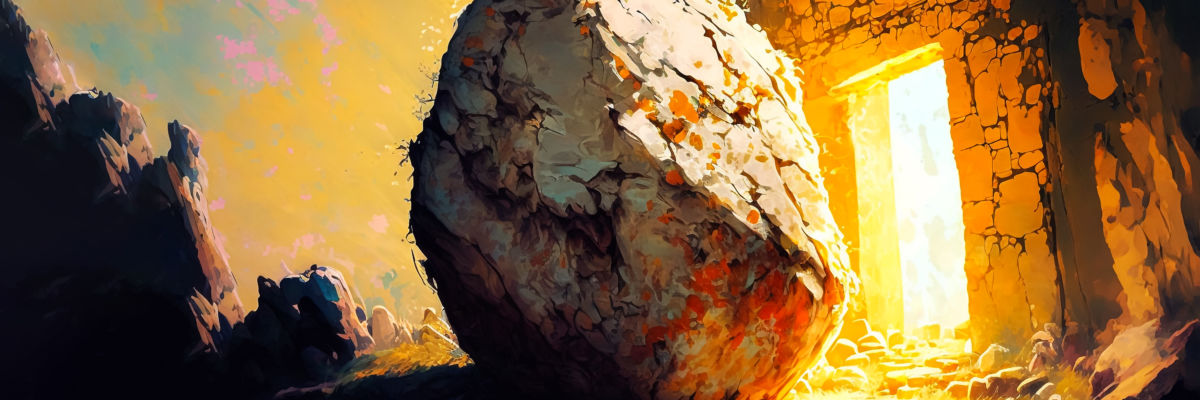
Babies make me cry.
Bear with me. I promise this does have something to do with Easter.
I have six living children. (Let’s just rip off the Band-Aid real quick, shall we? If you don’t know who I am, yes, I’m a Catholic priest, and yes, I’m married thanks to the generous permission of the Holy Father for formerly Protestant ministers.) We’ve also had a couple of miscarriages, and those made me cry, too, for obvious reasons. But the regular live births all left me bawling like a baby myself.
I’ve never quite figured out why. But I think there’s something about a birth that brings us into direct contact with the thin line between life and death, between existence and nonexistence. To enter this life is to hover for a series of moments over nothingness. And when the end of labor comes—and I say this not as the one actively laboring, but as the one watching and waiting and hoping—it is a profound moment of joy mingled with pain and relief and a kind of incalculable heartache. For you hold in your hands a new life, but to do so is to say at the same time: my life is yours. I will take on the cost of your existence from this day on.
Maybe now you’re wondering if this is a mistake, and you’ve accidentally come to Mass on Christmas in April. But here’s the thing: the tomb is a womb. The baptismal font is the womb of the Church. From it, we are reborn into Christ. In baptism, we are buried with Christ. The womb of the Church is the place where Jesus lay dead, the place whence he emerged with new life on Easter morning. And this new life is a gift that mingles with all the sorrow of its history.
To receive this new life, to be baptized into this new life, is to acknowledge, as we must do with a new baby, the ways that this new life has been entrusted to us as a gift, the ways too that this gift has a particular history that cannot be erased. It is not ours any more than a new child is ours. But it is given to us—to nurture, to love, or to neglect.
We have witnessed this long labor over the last few days—the betrayal of Jesus, his unjust trial and horrible execution. In a way, my analogy of paternity works in its sense of distance—we see these things, we feel them in a certain way, though they are not exactly ours to know directly. But there’s a difference here that’s important. For in the passion of Christ, our humanity is a real agent. It may be at a distance from us historically, or experientially, but the “deep magic” of the cross is useless to us if it is not fully human, fully ours. In his labor, Jesus suffers not just for us in some purely substitutionary way, like a cosmic surrogate. We suffer with him not simply because his suffering is “for us” in some technical legal way, but because he really is us. By offering his life, he offers human life in all its glory and potential and sorrow. And, like the total gift of self that we call marriage, this gift bears fruit.
Now, you might think all this talk of the resurrection as a gift is just a fancy way of explaining its symbolic value. As usual, this season, I’ve received several mass-mailers from local nondenominational churches inviting the local populace in for free cinnamon rolls and an inspiring talk about something like “resurrection power” to change your life. If we’re talking about Jesus, this can’t become an abstraction. He didn’t rise in the hearts of his disciples, or give some new mystical hope for the downhearted. The center of all this is an actual physical body that bursts out of the tomb in new life.
Jesus’ resurrection is, as St. Paul tells us, the “first fruits” of the Resurrection. It is the seed from which all else grows. Thus, the fundamental “power” of the Resurrection that Christians in every age have received is not an abstract concept of new life, but this new life itself in its own substance. In other words, the resurrected body of Jesus isn’t just something back then two thousand years ago; it is given to us today and every day in the altars and tabernacles of the Catholic Church. What the Lord gives us is not first something to think about, but something to eat. He gives us himself.
This food and drink, the bread of life and the cup of salvation, are the new birth of humanity. Paul says that when we eat this bread and drink this cup, we proclaim the Lord’s death until he comes (1 Cor. 11:26). That is because to receive this new life is to receive its entire personal history. All the horror of death and corruption, all the decay and evil of human history, reach their climax in the cross. In the resurrection of Jesus, they are remembered—even in a sense of what is yet to come—but rather than being signs of death, they have become the glorious scars of Jesus, the marks of his victory in battle for and with us.
Hear then today the gospel of Jesus. The good news isn’t just that Jesus has died for our sins and risen to life, nor is it just that we can be forgiven our sins, though both of those things are true. It is that we are invited to share in his life now—not just as some nice hope for the future, where we can find life after death, but as life after death now. For Jesus has emerged from the tomb, and rather than go after his enemies with the sword, he approaches them—us, that is—with the gift of his body and blood, his life and divinity. Let us receive him with all the joy and sorrow and gratitude that we can, knowing that his life is ours and that, like a newborn child, he demands of us not just love and affection, but everything—a life re-ordered around him.



